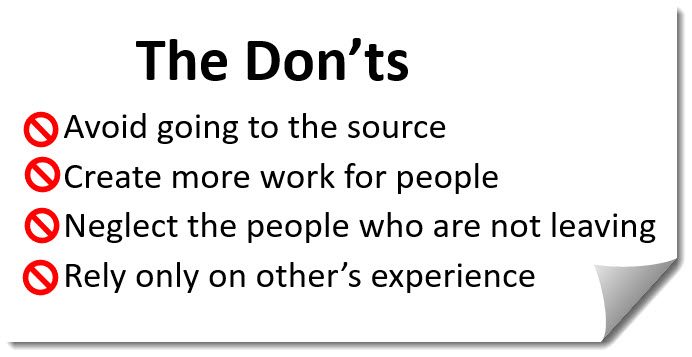Retention – it seems to be on everyone’s radar these days – and with good reason. Existing staff shortages, early retirements and potential resignations have us all thinking about ways to hold on to the staff that we have. There are a lot of great ideas out there about how to go about accomplishing this – the “Do’s”. These offer many helpful ways to approach the issues, increase teacher satisfaction, etc. But part of the puzzle involves not doing things that make the problem worse. Let’s look at some of the “Don’ts” – those things to avoid as we address retention.

Don’t – Avoid going to the source – the ones who can speak most eloquently about why they are leaving are the ones who are leaving. It can be tempting to avoid “bad news” or frustration, but this information provides a wealth of useful data that can be used to take action moving forward. Is there an existing process for finding out why they have left and what might have made them stay?
Don’t – Create more work for people – it may be an honor to be selected to sit on a task force, provide input on a critical problem, etc., but the reality is that these responsibilities and requests get added to an already overflowing plate. People can resent these ways to contribute as they struggle to just stay on top of day-to-day activities. Given that getting their input is essential, in what ways can you mitigate the extra burden or incent their involvement?
Don’t – Neglect the people who are not leaving – most of your workforce is not resigning (although it might sometimes feel otherwise). What can we learn from them? They are the ones in the trenches who have timely, accurate information and experiences – what makes them stay? What would make their jobs easier? What would they like to see changed? How can we make sure they feel appreciated and valued?
Don’t – Generalize or rely only on others’ experience from other schools and districts – certainly there are things to learn from other districts, schools, departments, etc. But a targeted solution requires that you really understand what is happening around retention in your district, school, or department – and why. Doing that requires embracing the data – taking a good hard look at the reality and knowing what is and is not working for people. You must involve stakeholders in the problem solving. If you don’t, you’ve missed a golden opportunity – and any solutions risk being seen as off-base, out of touch, or top-down (and thus potentially lacking in credibility and support).
All districts have a unique set of experiences
Each school and district needs to grapple with their own experience of staff shortages and what is contributing to them. Process tools like TregoED’s Situation Appraisal, Problem Analysis, etc. can help you collect, sort, and analyze data to help define and develop solutions to the problem. As Aristotle said, “A problem well-defined is half-solved.” We can borrow and tailor ideas from other districts about effective ways to address it, but we can also intentionally avoid doing things which either exacerbate the problem or miss the mark. Increasing retention is a complex problem that can be hard to wrap our heads around – but like all big problems, it is easier to deal with when we clearly define it and understand it, involve stakeholders and get creative about how to address it.